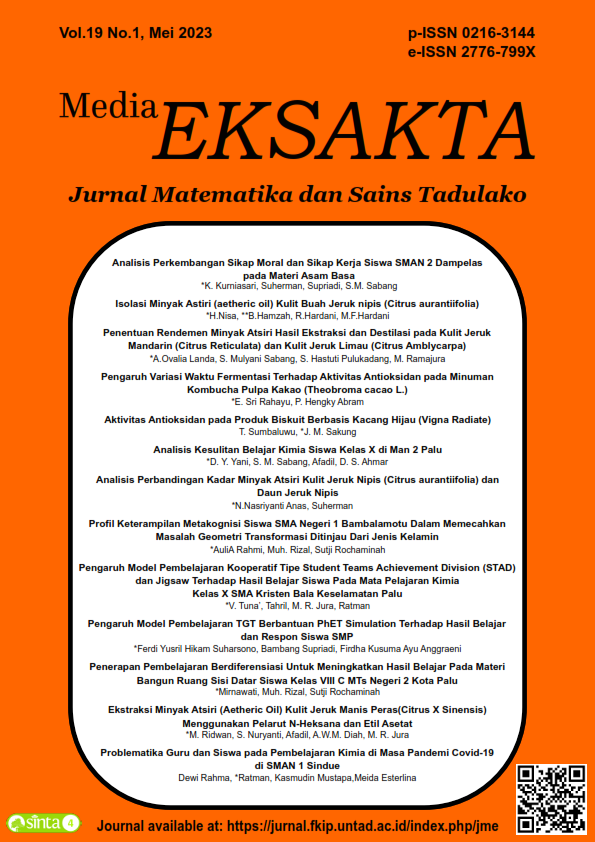Identification of Students' Concept Understanding and Self-Efficacy in Atomic Structure and Periodic System
DOI:
https://doi.org/10.22487/me.v19i1.1083Keywords:
Concept understanding, self efficacy, Atomic structure, Periodic systemAbstract
Understanding the concept is a process in which students are able to understand the information obtained, both the definition, nature and description of a concept so that they are able to construct the concept. Self Efficacy is the ability of individuals to organize the actions needed for certain achievements. This study aims to (1) describe students' conceptual understanding of atomic structure material and the periodic system of elements. (2) describe student self-efficacy in atomic structure material and the periodic system of elements. The type of research used in this study was descriptive research with a quantitative approach. The instruments used in this study were three-tier questions and self-efficacy questionnaires. This research was conducted at SMAN 4 Palu in class X MIPA students. The results showed that students' understanding of concepts in atomic structure material and the periodic system of elements averaged the percentage of students who understood the concept of 34.35% classified as understanding the concept of the low category, students who did not understand the concept of 24.1% were in the low category while students who experienced a misconception of 41.35% in the sufficient category. The results of student self-efficacy research show that student self-efficacy is good because most are in the high category of 45 students (75%), the sufficient category is 15 students (25%).
References
Safitri, A. F. S., Hayuni, R.W, & Dedek, S, “Identifikasi Pemahaman Konsep Ikatan Kimia”. Jurnal Pembelajaran Kimia, 3(1), 2018, pp. 41-50.
Raisul, M., Tahril & Afadil. “Misconception Reduction By Implementing Contextual Teaching And Learning (CTL) Approach On Salt Hydrolysis Material In Grade XI At SMA 1 Palasa”. Jurnal Akademika Kimia 9(2), 2020, pp. 78-86.
Sari, D. S., &Muchlis. “Penerapan Model Pembelajaran Learning Cycle 5-E Untuk Meningkatkan Pemahaman Konsep Siswa Pada Materi Redoks Kelas X SMA Negri 1 Dryorejo Gresik”. Unesa Journal Of Chemical Education, 8(3), 2019, pp. 305-312.
Radiko, E., Yudi, K, & Riski, M, “Identifikasi Pemahaman Konsep Siswa Pada Materi Zat Dan Wujudnya”. Jurnal Ilmu Pendidikan Fisika, 3(2), 2018, pp. 52-54.
Vellayati, S., Cut Nurmaliah., Sulastri., Yusrizal, dan Nurdin, S, “Identifikasi Tingkat Pemahaman Konsep Siswa Menggunakan Tes Diagnostik Three-Tier Multiple Choice Pada Materi Hidrokarbon”. Jurnal Pendidikan Sains Indonesia, 8(1), 2020, pp. 128-140.
Nursa’adah, F. P., & Arfatin, N. “Pengaruh Kemampuan Dasar Matematika Dan Efikasi Diri Terhadap Pemahaman Konsep Kimia”. Simposium Nasional Ilmiah, 2019, pp. 214-220.
Aryungga, S. D. E., & Farida, H. “Kemudahan eliminasi Miskonsepsi Ikatan Kimia Pada Siswa Dengan Efikasi Diri Yang Berbeda”. Jurnal Pendidikan Modern, 5(2), 2020, pp., 57-62.
Izzati, S., Sunyono, & Efkar, T. “Penerapan SiMaYang Tipe II Berbasis Multipel Representasi Pada Materi Asam Basa”. Jurnal Pendidikan Dan Pembelajaran Kimia. 1(4), 2015, pp. 262-274.
Jatisunda, M.G. “Hubungan Self Efficacy Siswa SMP Dengan Kemampuan Pemecahan Masalah Matematis”. Jurnal THEOREMS 1(2), 2017, pp. 24-76
Rahman, S., Netty, I. I, dan Mangara, S. “Identifikasi Kesulitan Siswa Dalam Memahami Konsep Hubungan Konfigurasi Elektron Dan Sistem Priodik Unsur”. Jurnal Entrop, 11(2), 2016, pp. 102-130
Rachmawati, Y., Ma’arif., Ninik, F & Nailil, I. “Studi Eksplorasi Pembelajaran Pendidikan IPA Pada Masa Pandemi Covid-19 di Uin Sunan Ampel Surabaya”. Jurnal IJSL 1(2), 2020, pp. 32-46
Sugiyono. Metode Penelitian Pendidikan. Bandung: Alfabeta, 2015
Susanto, A. Teori Belajar Dan Pembelajaran Di Sekolah Dasar. Jakarta: Kencana, 2013
Resmiati, T., & Hamdan. “Analisis Kemampuan Pemecahan Masalah Matematis dan Self-Efficacy Siswa Sekolah Menengah Pertama”. Jurnal Pembelajaran Matematika Inovatif, 2(4), 2019, pp. 177-186.
Rukajat. Pendekatan Penelitian Kuantitatif. Sleman: Cv. Budi Utama, 2018.
Mahmudin, H. M., & Suroso. “Efikasi Diri, Dukungan Sosial Dan Penyesuaian Diri Dalam Belajar”. Jurnal Psikologi Indonesia, 3(2), 2014, pp. 183-194.
Sudaryo, Y., Nunung, Adam, M., & Ana, H, Metode Penelitian Survey Online Dengan Google Forms. Yogyakarta: Cv. Andi Offset, 2019
Downloads
Published
How to Cite
License
Copyright (c) 2024 Nurwahyuni Nurwahyuni, Sri Hastuti Virgianti, Afadil Afadil

This work is licensed under a Creative Commons Attribution-ShareAlike 4.0 International License.
Authors who publish with Jurnal Media Eksakta agree to the following terms:
- Authors retain copyright and grant the journal right of first publication with the work simultaneously licensed under a Creative Commons Attribution License (CC BY-SA 4.0) that allows others to share the work with an acknowledgment of the work's authorship and initial publication in this journal.
- Authors are able to enter into separate, additional contractual arrangements for the non-exclusive distribution of the journal's published version of the work (e.g., post it to an institutional repository or publish it in a book), with an acknowledgment of its initial publication in this journal.
- Authors are permitted and encouraged to post their work online (e.g., in institutional repositories or on their website) prior to and during the submission process, as it can lead to productive exchanges, as well as earlier and greater citation of published work.




